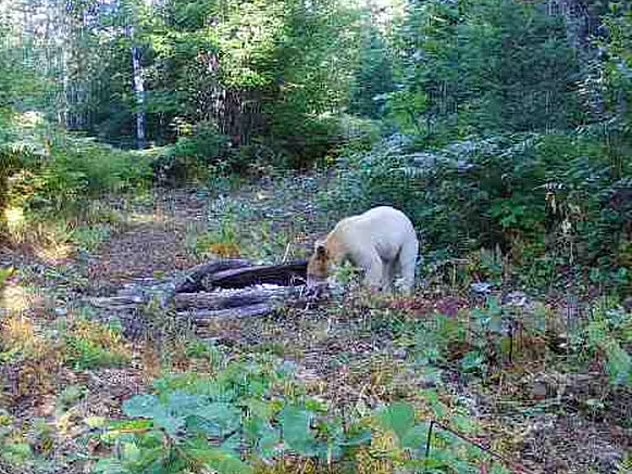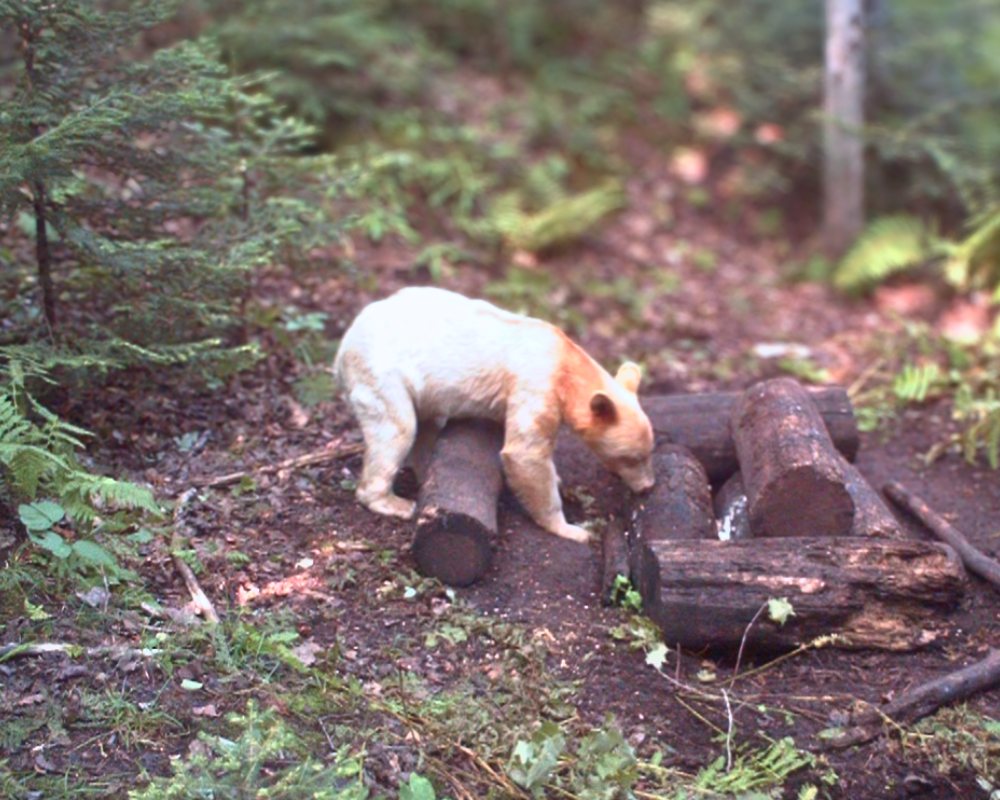In an extraordinary moment for nature and wildlife enthusiasts, a white black bear — a true one-in-a-million genetic marvel — has been spotted wandering the forests of Michigan’s Upper Peninsula. The 100-pound animal, captured on a trail camera in early September, is the first of its kind ever recorded in the state, making it one of the rarest animals ever seen in North America. Wildlife experts are calling it a “historic discovery” — and a story of survival that embodies both beauty and fragility in the wild.
A Once-in-a-Lifetime Sighting
The bear was captured on film by a local resident’s motion-activated trail camera, set up deep in Michigan’s western Upper Peninsula. The images, which appear almost mythical, show a snow-white bear moving gracefully through the forest — a sight so rare that it has left both scientists and locals in awe.
According to Cody Norton, a carnivore specialist with Michigan’s Department of Natural Resources (DNR), the creature is estimated to be around two years old and weighs roughly 100 pounds. Unlike an albino bear, which lacks pigment entirely, this animal’s white coat is the result of a double-recessive genetic trait that occurs only when both parents carry the rare gene.
“It’s incredibly rare — a true one-in-a-million,” Norton said. “We’ve seen cinnamon, blonde, and chocolate phases, but white is in a category of its own. It’s just exciting seeing an animal like this here instead of somewhere else.”
The Spirit of the Forest
White black bears, sometimes called “Spirit Bears,” have long held special significance among Native American and First Nations communities. They represent balance, renewal, and transformation — a reminder that the natural world is full of wonder and mystery.
According to Austin Ayres of the Keweenaw Bay Indian Community, the white bear carries deep spiritual symbolism for the Anishinaabe people.
“It is a sign of great change,” Ayres explained. “The bear reminds us that everything we need exists within nature. It is a message of healing and reflection — a sign for all people.”

📖 Full Story: Man Loses 360 Pounds Naturally—Internet Rallies to Support His Next Step
A Genetic Miracle in the Wild
Unlike the Kermode bears of British Columbia — where 10–20% of the population carry the white-fur gene — Michigan’s black bears rarely display this trait. The discovery is only the fifth recorded sighting of a white bear outside Canada in nearly a century.
Wildlife biologists believe that the bear’s coloration results from a recessive “white gene” that must be inherited from both parents — a genetic coincidence that’s virtually impossible in large, wide-ranging populations like those in the U.S. Midwest.
Renowned bear expert Lynn Rogers explained the phenomenon:
“It’s a double-recessive gene. When there are fewer of those genes in the population, getting a white bear is unbelievably rare. This Michigan bear is a true anomaly.”
The DNR hopes to collect a genetic sample if the bear is seen again, which could confirm whether its lineage is connected to the Canadian Kermode subspecies.
Between Wonder and Danger
As enchanting as the discovery is, it also brings concern. Michigan’s bear hunting season began September 7 and runs through October 14, leaving the animal vulnerable to both legal hunters and poachers. Unlike British Columbia, where Spirit Bears are protected by law, Michigan offers no special protections for bears with white fur.
“We’re asking everyone to keep an eye out,” Norton urged. “This bear is part of a living legend, and we want it to survive.”
Local wildlife enthusiasts fear not only hunters but also predators. A pack of wolves has been sighted in the same region — and one hunter even witnessed wolves devouring a nearby black bear carcass within minutes. The trail camera that recorded the white bear stopped detecting it soon after, leaving its fate uncertain.
Still, hope remains that the animal escaped deeper into the forest, away from human and animal threats alike.

Spirit Bears and the Story of Nature’s Balance
Spirit Bears, or white-furred black bears, have fascinated biologists for decades. Their pale coats provide surprising advantages in the wild — helping them camouflage against cloudy skies while hunting fish in rivers, an adaptation that enhances their success in catching prey like salmon.
In Canada’s Great Bear Rainforest, fewer than 400 white-colored bears exist, yet they play an outsized role in indigenous culture and ecosystem research. These animals have inspired generations of conservationists, storytellers, and spiritual leaders alike.
Now, with this Michigan sighting, a new chapter in that legacy begins.
📖 You Might Also Like: The Hidden Meaning Behind Princess Diana’s Cannes Gown — A Heartfelt Farewell to Grace Kelly
A Call for Conservation and Respect
For scientists, the discovery underscores the importance of genetic diversity and the need to protect even the most common wildlife species. For locals and Indigenous communities, it’s a reminder of how deeply our fates are tied to the natural world.
The resident who first captured the footage shared that he initially deleted the photos, thinking the camera flash had created the illusion of white fur. Only later, after more images appeared, did he realize what he had discovered.
“I couldn’t believe it,” he said. “I’ve hunted here all my life and never seen anything like it. Once I knew, I promised myself — no one’s ever going to harm that bear.”
His promise resonates beyond Michigan’s borders. The white bear’s existence invites reflection — urging humans to tread more carefully, to observe rather than conquer, and to preserve the wild magic that still survives among us.



